Bibliometric Analysis of Remote Sensing over Marine Areas for Sustainable Development: Global Trends and Worldwide Collaboration
Abstract
1. Introduction
- How have trends and challenges in RS research of marine areas for SD evolved?
- Who are the key contributors to this research field?
- Does the geographic distribution of RS research in marine areas influence the global achievement of the goal of SD?
2. Materials and Methods
3. Results
3.1. Scientific Productivity Trends
3.2. Science Mapping
4. Discussion
5. Conclusions
Author Contributions
Funding
Institutional Review Board Statement
Informed Consent Statement
Data Availability Statement
Acknowledgments
Conflicts of Interest
References
- World Ocean Volumes. Available online: https://www.ncei.noaa.gov/sites/g/files/anmtlf171/files/2023-01/World%20Ocean%20Volumes.pdf (accessed on 10 May 2024).
- Seabed 2023. Available online: https://seabed2030.org/ (accessed on 10 May 2024).
- Wölfl, A.-C.; Snaith, H.; Amirebrahimi, S.; Devey, C.W.; Dorschel, B.; Ferrini, V.; Huvenne, V.A.I.; Jakobsson, M.; Jencks, J.; Johnston, G.; et al. Seafloor Mapping—The Challenge of a Truly Global Ocean Bathymetry. Front. Mar. Sci. 2019, 6, 283. [Google Scholar] [CrossRef]
- United Nations. United Nations Convention on the Law of the Sea; United Nations: New York, NY, USA, 1982. [Google Scholar]
- Pyć, D. The Role of the Law of the Sea in Marine Spatial Planning. In Maritime Spatial Planning, 2nd ed.; Zaucha, J., Gee, K., Eds.; Palgrave Macmillan Cham: London, UK, 2019; pp. 375–395. [Google Scholar] [CrossRef]
- Zhang, S.; Wu, Q.; Butt, M.M.Z.; Lv, Y.-M.; Yan-E-Wang. International Legal Framework for Joint Governance of Oceans and Fisheries: Challenges and Prospects in Governing Large Marine Ecosystems (LMEs) under Sustainable Development Goal 14. Sustainability 2024, 16, 2566. [Google Scholar] [CrossRef]
- United Nations. Transforming Our World: The 2030 Agenda for Sustainable Development. Available online: https://sdgs.un.org/2030agenda (accessed on 10 May 2024).
- Millennium Goals. Available online: https://www.un.org/millenniumgoals/ (accessed on 10 May 2024).
- Ocean Decade. Available online: https://oceandecade.org/ (accessed on 10 May 2024).
- Contarinis, S.; Pallikaris, A.; Nakos, B. The Value of Marine Spatial Open Data Infrastructures—Potentials of IHO S-100 Standard tο Become the Universal Marine Data Model. J. Mar. Sci. Eng. 2020, 8, 564. [Google Scholar] [CrossRef]
- Rani, M.; Masroor, M.; Kumar, P. Remote Sensing of Ocean and Coastal Environment—Overview. In Earth Observation, Remote Sensing of Ocean and Coastal Environments; Rani, M., Seenipandi, K., Rehman, S., Kumar, P., Sajjad, H., Eds.; Elsevier: Amsterdam, The Netherlands, 2021; pp. 1–15. [Google Scholar]
- EO4SDG. Earth Observations in Service of the 2030 Agenda for Sustainable Development. Strategic Implementation Plan 2020–2024. Available online: https://eo4sdg.org/wp-content/uploads/2019/09/EO4SDG-Strategic-Impl.-Plan-2020-2024.pdf (accessed on 12 May 2024).
- Sandwell, D.T.; Muller, R.D.; Smith, W.H.; Garcia, E.; Francis, R. New global marine gravity model from CryoSat-2 and Jason-1 reveals buried tectonic structure. Science 2014, 346, 65–67. [Google Scholar] [CrossRef]
- Mumby, P.; Green, E.; Edwards, A.; Clark, C. Cost-effectiveness of remote sensing for coastal management. J. Environ. Manag. 1999, 55, 157–166. [Google Scholar] [CrossRef]
- Wang, K.; Franklin, S.E.; Guo, X.; Cattet, M. Remote Sensing of Ecology, Biodiversity and Conservation: A Review from the Perspective of Remote Sensing Specialists. Sensors 2010, 10, 9647–9667. [Google Scholar] [CrossRef]
- Mayer, L.; Jakobsson, M.; Allen, G.; Dorschel, B.; Falconer, R.; Ferrini, V.; Lamarche, G.; Snaith, H.; Weatherall, P. The Nippon Foundation—GEBCO Seabed 2030 Project: The Quest to See the World’s Oceans Completely Mapped by 2030. Geosciences 2018, 8, 63. [Google Scholar] [CrossRef]
- Martín-Martín, A.; Orduna-Malea, E.; Thelwall, M.; Delgado López-Cózar, E. Google Scholar, Web of Science, and Scopus: A Systematic Comparison of Citations in 252 Subject Categories. J. Informetr. 2018, 12, 1160–1177. [Google Scholar] [CrossRef]
- Donthu, N.; Kumar, S.; Mukherjee, D.; Pandey, N.; Lim, W.M. How to conduct a bibliometric analysis: An overview and guidelines. J. Bus. Res. 2021, 133, 285–296. [Google Scholar] [CrossRef]
- van Eck, N.J.; Waltman, L. Software survey: VOSviewer, a computer program for bibliometric mapping. Scientometrics 2010, 84, 523–538. [Google Scholar] [CrossRef] [PubMed]
- Aria, M.; Cuccurullo, C. Bibliometrix: An R-tool for comprehensive science mapping analysis. J. Informetr. 2017, 11, 959–975. [Google Scholar] [CrossRef]
- Zhang, H.; Huang, M.; Qing, X.; Li, G.; Tian, C. Bibliometric Analysis of Global Remote Sensing Research during 2010–2015. ISPRS Int. J. Geo-Inf. 2017, 6, 332. [Google Scholar] [CrossRef]
- Araya-Lopez, R.; de Paula Costa, M.D.; Wartman, M.; Macreadie, P.I. Trends in the application of remote sensing in blue carbon science. Ecol. Evol. 2023, 13, e10559. [Google Scholar] [CrossRef]
- Wang, Q.; Wang, J.; Xue, M.; Zhang, X. Characteristics and Trends of Ocean Remote Sensing Research from 1990 to 2020: A Bibliometric Network Analysis and Its Implications. J. Mar. Sci. Eng. 2022, 10, 373. [Google Scholar] [CrossRef]
- Ekmen, O.; Kocaman, S. Remote sensing for UN SDGs: A global analysis of research and collaborations. Egypt. J. Remote Sens. Space Sci. 2024, 27, 329–341. [Google Scholar] [CrossRef]
- Chen, G.; Yang, R.; Zhao, X.; Li, L.; Luo, L.; Liu, H. Bibliometric Analysis of Spatial Technology for World Heritage: Application, Trend and Potential Paths. Remote Sens. 2023, 15, 4695. [Google Scholar] [CrossRef]
- Chen, C.-H.; Yen, K.-W. Developing International Collaboration Indicators in Fisheries Remote Sensing Research to Achieve SDG 14 and 17. Sustainability 2023, 15, 14031. [Google Scholar] [CrossRef]
- Moral-Muñoz, J.A.; Herrera-Viedma, E.; Santisteban-Espejo, A.; Cobo, M.J. Software tools for conducting bibliometric analysis in science: An up-to-date review. El Prof. De La Inf. 2019, 29, e290103. [Google Scholar] [CrossRef]
- Bibliometrix. Available online: https://www.bibliometrix.org/home/index.php/download (accessed on 15 May 2024).
- Mongeon, P.; Paul-Hus, A. The journal coverage of Web of Science and Scopus: A comparative analysis. Scientometrics 2016, 106, 213–228. [Google Scholar] [CrossRef]
- Pranckutė, R. Web of Science (WoS) and Scopus: The Titans of Bibliographic Information in Today’s Academic World. Publications 2021, 9, 12. [Google Scholar] [CrossRef]
- Wang, Q.; Waltman, L. Large-scale analysis of the accuracy of the journal classification systems of Web of Science and Scopus. J. Informetr. 2016, 10, 347–364. [Google Scholar] [CrossRef]
- Liu, C.; Li, W.; Xu, J.; Zhou, H.; Li, C.; Wang, W. Global trends and characteristics of ecological security research in the early 21st century: A literature review and bibliometric analysis. Ecol. Indic. 2022, 137, 108734. [Google Scholar] [CrossRef]
- Pohl, C.; Van Genderen, J.L. Review Article Multisensor Image Fusion in Remote Sensing: Concepts, Methods and Applications. Int. J. Remote Sens. 1998, 19, 823–854. [Google Scholar] [CrossRef]
- Carpenter, C.R.; Cone, D.C.; Sarli, C.C. Using publication metrics to highlight academic productivity and research impact. Acad. Emerg. Med. 2014, 21, 1160–1172. [Google Scholar] [CrossRef] [PubMed] [PubMed Central]
- Kozoderov, V.V. A Scientific Approach to Employ Monitoring and Modelling Techniques for Global Change and Terrestrial Ecosystems and Other Related Projects. J. Biogeogr. 1995, 22, 927–933. [Google Scholar] [CrossRef]
- Carr, M.-E. Estimation of potential productivity in Eastern Boundary Currents using remote sensing. Deep Sea Res. Part II Top. Stud. Oceanogr. 2001, 49, 59–80. [Google Scholar] [CrossRef]
- Petropoulos, G.P.; Ireland, G.; Barrett, B. Surface soil moisture retrievals from remote sensing: Current status, products & future trends. Phys. Chem. Earth Parts A/B/C 2015, 83–84, 36–56. [Google Scholar] [CrossRef]
- Chen, B.; Xiao, X.; Li, X.; Pan, L.; Doughty, R.; Ma, J.; Dong, J.; Qin, Y.; Zhao, B.; Wu, Z.; et al. A mangrove forest map of China in 2015: Analysis of time series Landsat 7/8 and Sentinel-1A imagery in Google Earth Engine cloud computing platform. ISPRS J. Photogramm. Remote Sens. 2017, 131, 104–120. [Google Scholar] [CrossRef]
- McArthur, M.A.; Brooke, B.P.; Przeslawski, R.; Ryan, D.A.; Lucieer, V.L.; Nichol, S.; McCallum, A.W.; Mellin, C.; Cresswell, I.D.; Radke, L.C. On the use of abiotic surrogates to describe marine benthic biodiversity. Estuar. Coast. Shelf Sci. 2010, 88, 21–32. [Google Scholar] [CrossRef]
- Wu, J.; Zhang, Q.; Li, A. Historical landscape dynamics of Inner Mongolia: Patterns, drivers, and impacts. Landsc. Ecol. 2015, 30, 1579–1598. [Google Scholar] [CrossRef]
- Appeaning Addo, K.; Walkden, M.; Mills, J.P. Detection, Measurement and Prediction of Shoreline Recession in Accra, Ghana. ISPRS J. Photogramm. Remote Sens. 2008, 63, 543–558. [Google Scholar] [CrossRef]
- Aschbacher, J.; Milagro-Pérez, M.P. The European Earth Monitoring (GMES) Programme: Status and Perspectives. Remote Sens. Environ. 2012, 120, 3–8. [Google Scholar] [CrossRef]
- Islam, M.A.; Mitra, D.; Dewan, A.; Akhter, S.H. Coastal Multi-Hazard Vulnerability Assessment along the Ganges Deltaic Coast of Bangladesh—A Geospatial Approach. Ocean Coast. Manag. 2016, 127, 1–15. [Google Scholar] [CrossRef]
- Radiarta, I.N.; Saitoh, S.-I.; Miyazono, A. GIS-Based Multi-Criteria Evaluation Models for Identifying Suitable Sites for Japanese Scallop (Mizuhopecten yessoensis) Aquaculture in Funka Bay, Southwestern Hokkaido, Japan. Aquaculture 2008, 284, 127–135. [Google Scholar] [CrossRef]
- Wabnitz, C.C.; Andréfouët, S.; Torres-Pulliza, D.; Müller-Karger, F.E.; Kramer, P.A. Regional-Scale Seagrass Habitat Mapping in the Wider Caribbean Region Using Landsat Sensors: Applications to Conservation and Ecology. Remote Sens. Environ. 2008, 112, 3455–3467. [Google Scholar] [CrossRef]
- Cullen, J.J. Primary Production Methods. In Encyclopedia of Ocean Sciences; Steele, J.H., Ed.; Academic Press: Cambridge, MA, USA, 2001; pp. 2277–2284. ISBN 9780122274305. [Google Scholar] [CrossRef]
- Pekel, J.F.; Cottam, A.; Gorelick, N.; Belward, A.S. High-resolution mapping of global surface water and its long-term changes. Remote Sens. 2016, 8, 810. [Google Scholar] [CrossRef] [PubMed]
- Wang, X.; Xiao, X.; Zou, Z.; Hou, L.; Qin, Y.; Dong, J.; Doughty, R.B.; Chen, B.; Zhang, X.; Chen, Y.; et al. Mapping Coastal Wetlands of China Using Time Series Landsat Images in 2018 and Google Earth Engine. ISPRS J. Photogramm. Remote Sens. 2020, 163, 312–326. [Google Scholar] [CrossRef] [PubMed]
- Gao, B.C. 1996. NDWI—A normalized difference water index for remote sensing of vegetation liquid water from space. Remote Sens. Environ. 1996, 58, 257–266. [Google Scholar] [CrossRef]
- Tucker, C.J. Red and Photographic Infrared Linear Combinations for Monitoring Vegetation. Remote Sens. Environ. 1979, 8, 127–150. [Google Scholar] [CrossRef]
- Gholizadeh, M.H.; Melesse, A.M.; Reddi, L. A Comprehensive Review on Water Quality Parameters Estimation Using Remote Sensing Techniques. Sensors 2016, 16, 1298. [Google Scholar] [CrossRef]
- Morel, A.; Prieur, L. Analysis of variations in ocean color. Limnol. Oceanogr. 1977, 22, 709–722. [Google Scholar] [CrossRef]
- Huang, C.; Song, K.; Kim, S.; Townshend, J.R.G.; Davis, P.; Masek, J.G.; Goward, S.N. Use of a dark object concept and support vector machines to automate forest cover change analysis. Remote Sens. Environ. 2008, 112, 970–985. [Google Scholar] [CrossRef]
- Gorelick, N.; Hancher, M.; Dixon, M.; Ilyushchenko, S.; Thau, D.; Moore, R. Google Earth Engine: Planetary-scale geospatial analysis for everyone. Remote Sens. Environ. 2017, 202, 18–27. [Google Scholar] [CrossRef]
- Mcleod, E.; Chmura, G.L.; Bouillon, S.; Salm, R.; Björk, M.; Duarte, C.M.; Lovelock, C.E.; Schlesinger, W.H.; Silliman, B.R. A blueprint for blue carbon: Toward an improved understanding of the role of vegetated coastal habitats in sequestering CO2. Front. Ecol. Environ. 2011, 9, 552–560. [Google Scholar] [CrossRef] [PubMed]
- Foody, G.M. Status of land cover classification accuracy assessment. Remote Sens. Environ. 2002, 80, 185–201. [Google Scholar] [CrossRef]
- Ivushkin, K.; Bartholomeus, H.; Bregt, A.K.; Pulatov, A.; Kempen, B.; De Sousa, L. Global mapping of soil salinity change. Remote Sens. Environ. 2019, 231, 111260. [Google Scholar] [CrossRef]
- Brammer, H. Bangladesh’s dynamic coastal regions and sea-level rise. Climate Risk Manag. 2014, 1, 51–62. [Google Scholar] [CrossRef]
- Adger, W.N. Vulnerability. Glob. Environ. Change 2006, 16, 268–281. [Google Scholar] [CrossRef]
- Gupta, K.; Mukhopadhyay, A.; Giri, S.; Chanda, A.; Majumdar, S.D.; Samanta, S.; Mitra, D.; Samal, R.N.; Pattnaik, A.K.; Hazra, S. An index for discrimination of mangroves from non-mangroves using LANDSAT 8 OLI imagery. MethodsX 2018, 5, 1129–1139. [Google Scholar] [CrossRef] [PubMed]
- Funk, C.; Peterson, P.; Landsfeld, M.; Pedreros, D.; Verdin, J.; Shukla, S.; Husak, G.; Rowland, J.; Harrison, L.; Hoell, A.; et al. The climate hazards infrared precipitation with stations—A new environmental record for monitoring extremes. Sci Data 2015, 2, 150066. [Google Scholar] [CrossRef]
- McKee, K.L.; Cahoon, D.R.; Feller, I.C. Caribbean mangroves adjust to rising sea level through biotic controls on change in soil elevation. Glob. Ecol. Biogeogr. 2007, 16, 545–556. [Google Scholar] [CrossRef]
- OCTGA. Available online: https://classroom.oceanteacher.org/ (accessed on 10 May 2024).
- IHO Capacity Building & Technical Cooperation. Available online: https://iho.int/en/capacity-building-and-technical-cooperation (accessed on 10 May 2024).
- Tzachor, A.; Hendel, O.; Richards, C.E. Digital twins: A stepping stone to achieve ocean sustainability? NPJ Ocean Sustain. 2023, 2, 16. [Google Scholar] [CrossRef]
- Racetin, I.; Ostojić Škomrlj, N.; Peko, M.; Zrinjski, M. Fuzzy Multi-Criteria Decision for Geoinformation System-Based Offshore Wind Farm Positioning in Croatia. Energies 2023, 16, 4886. [Google Scholar] [CrossRef]
- Tian, Y.; Yang, Z.; Yu, X.; Jia, Z.; Rosso, M.; Dedman, S.; Zhu, J.; Xia, Y.; Zhang, G.; Yang, J.; et al. Can we quantify the aquatic environmental plastic load from aquaculture? Water Res. 2022, 219, 118551. [Google Scholar] [CrossRef]
- WoS SDG Mapping. Available online: https://incites.help.clarivate.com/Content/Research-Areas/sustainable-development-goals.htm (accessed on 1 June 2024).

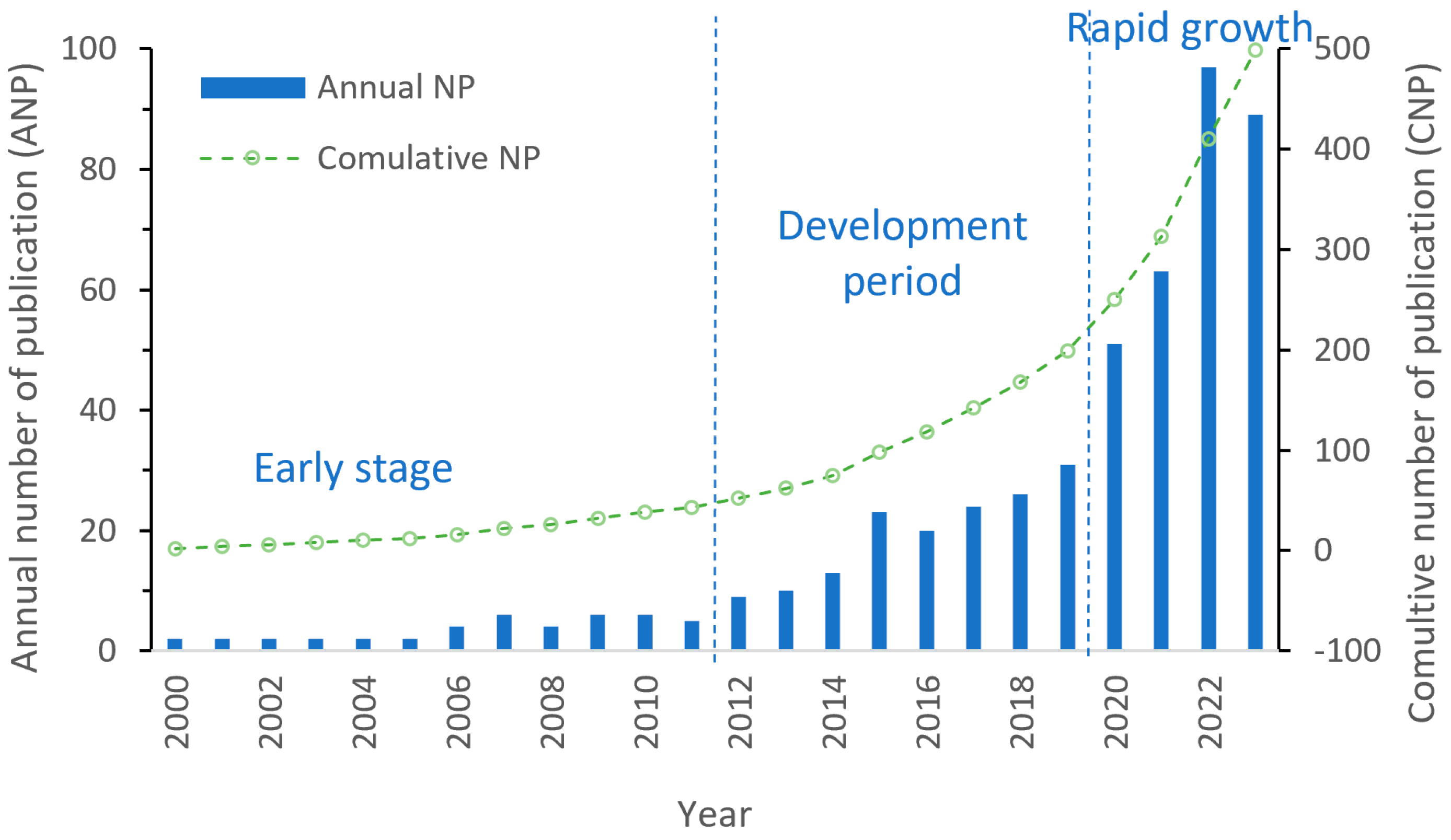
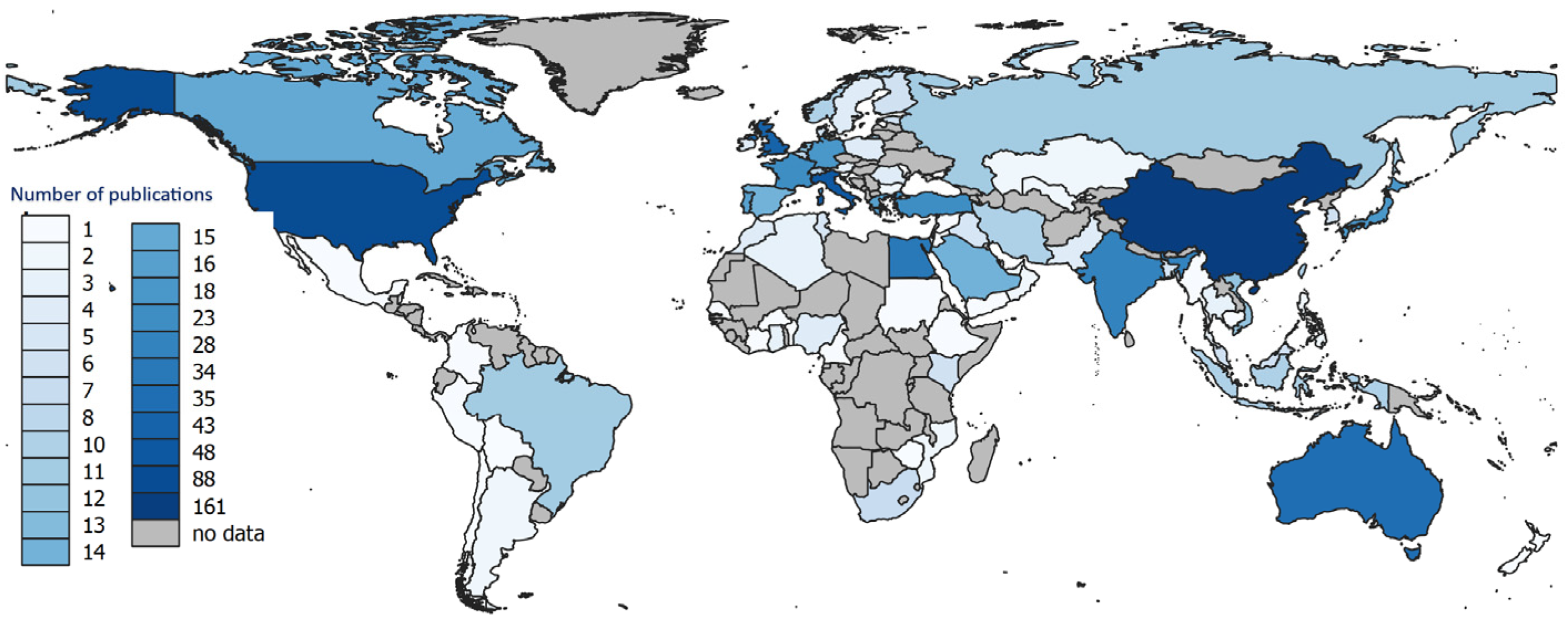
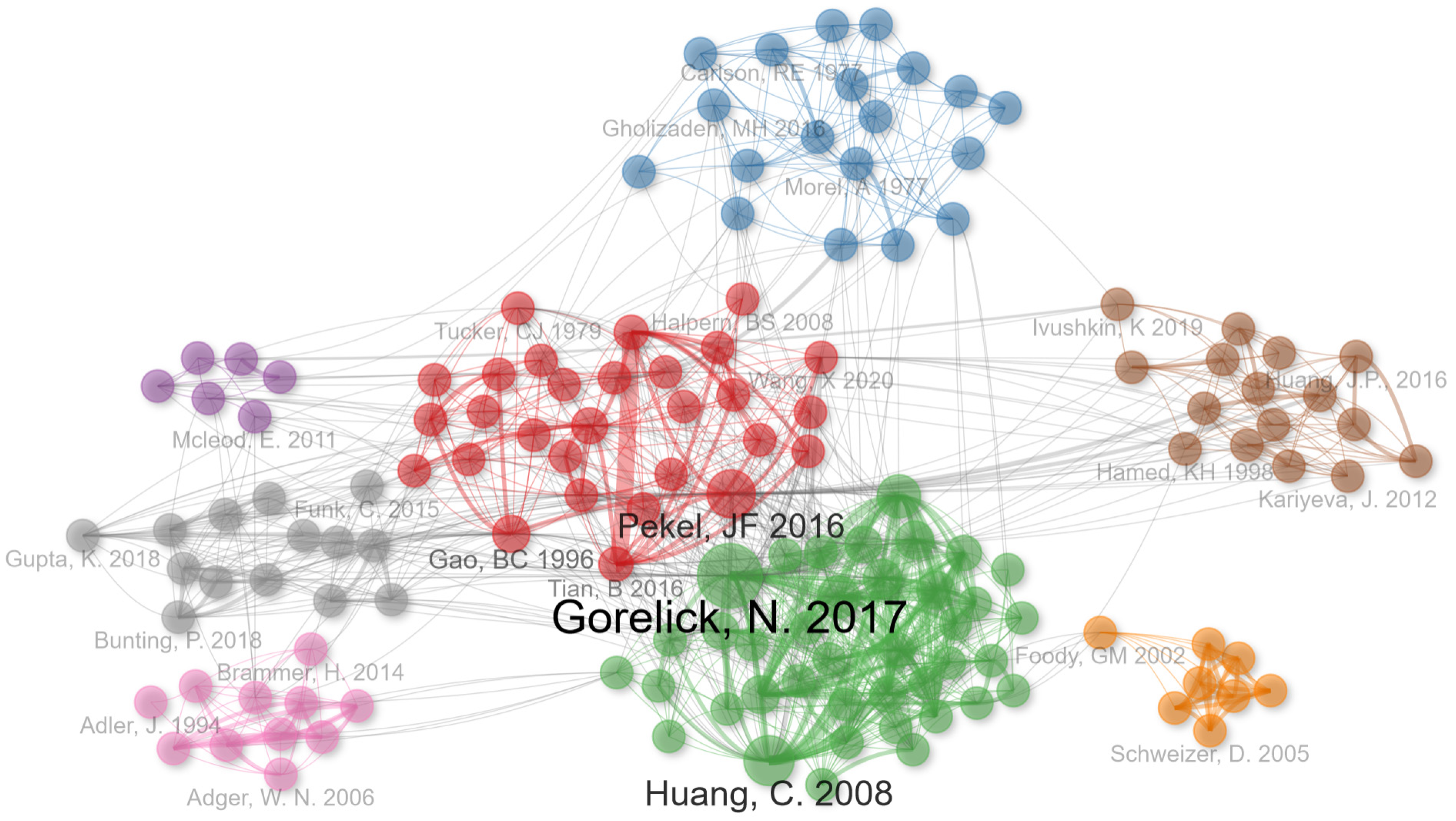
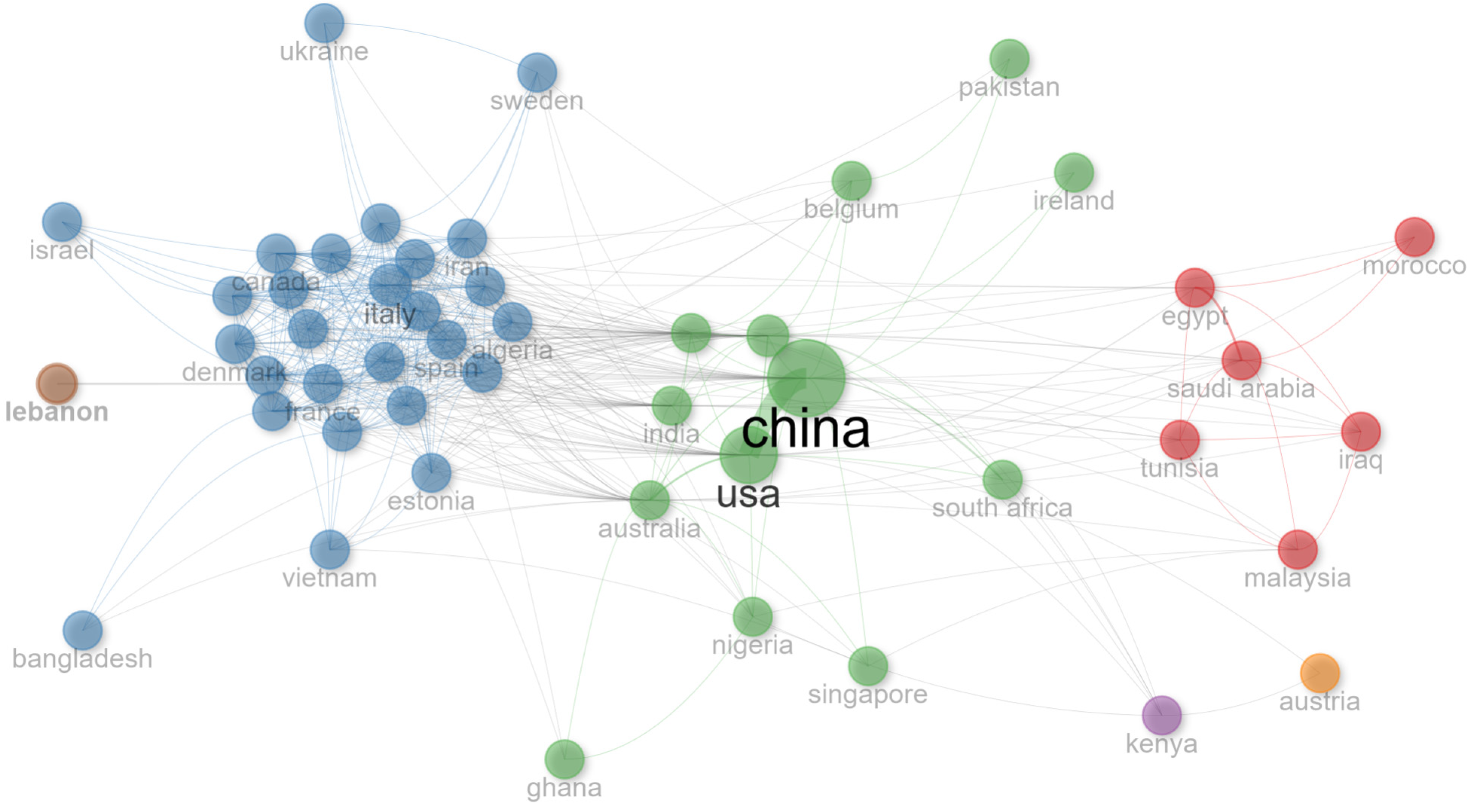
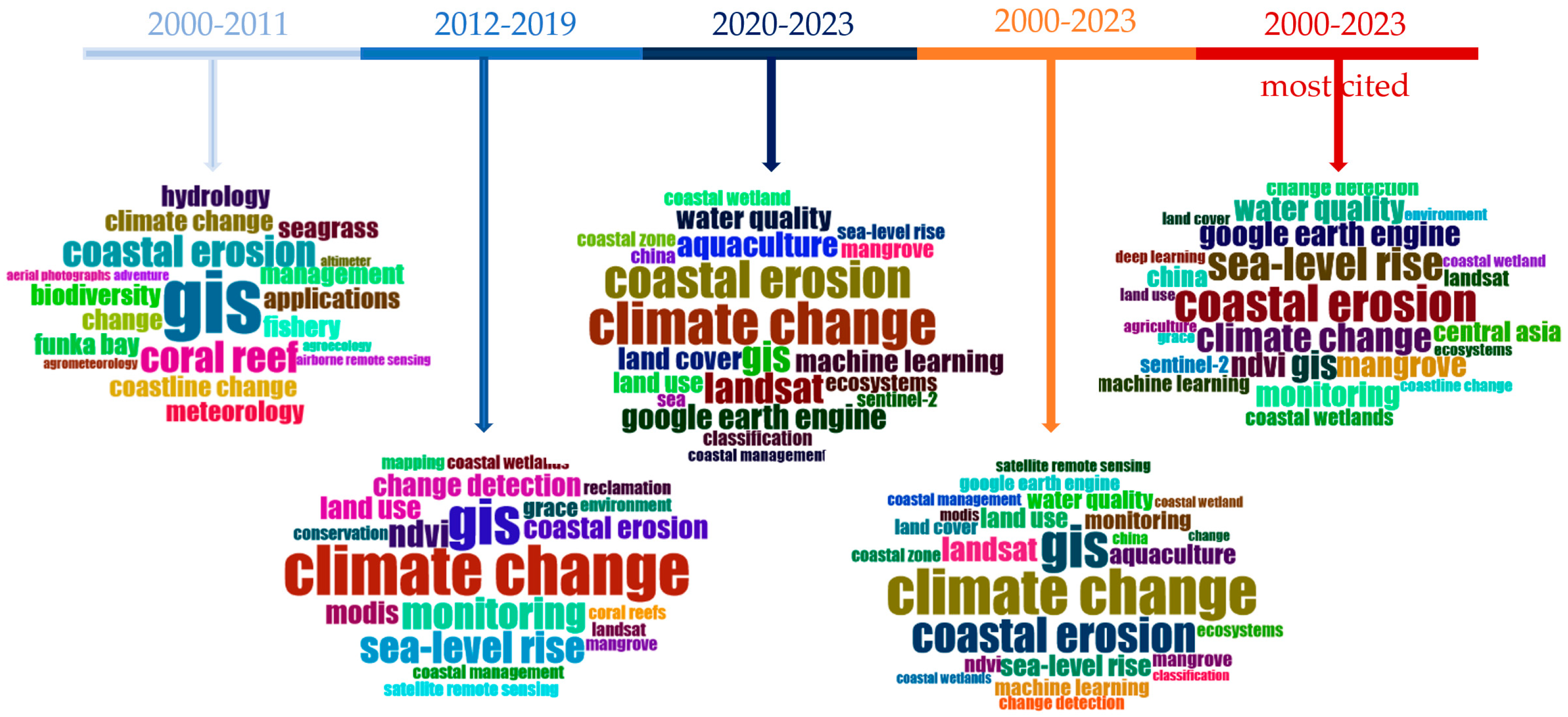
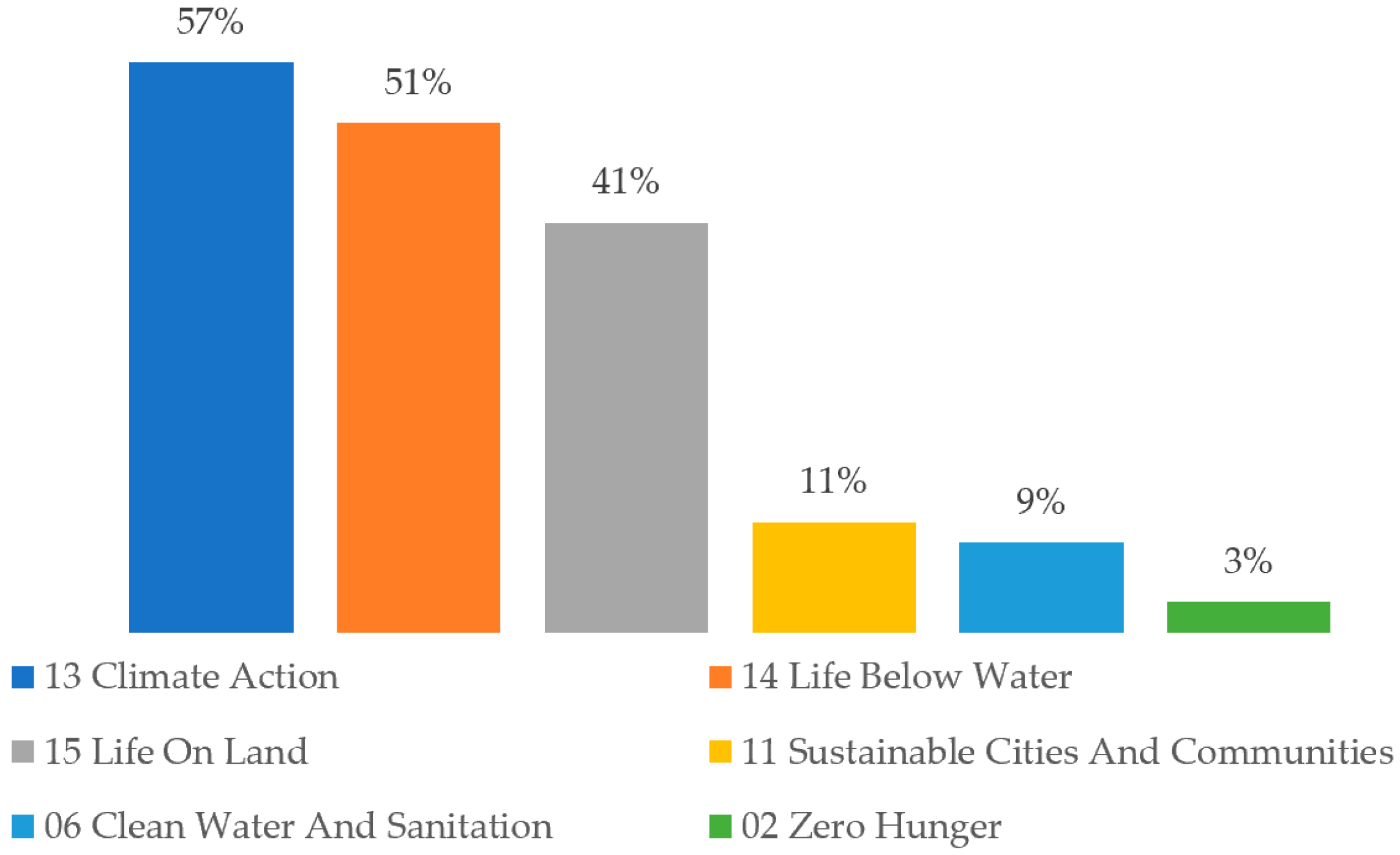
| Main Information | Description | Results |
|---|---|---|
| Data | Timespan | 2000–2023 |
| Journals | 215 | |
| Articles | 499 | |
| Average citations per doc | 18.97 | |
| Annual growth rate % | 17.94 | |
| References | 27,256 | |
| Content | Keywords plus (ID) | 1525 |
| Author keywords (DE) | 1955 | |
| Authors | Authors | 2734 |
| Single-author docs | 27 | |
| Co-authors per doc | 6.41 | |
| International co-authorships % | 36.87 |
| Journal | NP 1 | IF2022 2 | Publisher | TC 3 |
|---|---|---|---|---|
| Remote Sensing | 44 | 5 | MDPI | 518 |
| Sustainability | 24 | 3.9 | MDPI | 157 |
| Ocean & Coastal Management | 16 | 4.6 | Elsevier | 379 |
| Science of the Total Environment | 14 | 9.8 | Elsevier | 284 |
| Environmental Monitoring and Assessment | 11 | 3 | Springer | 173 |
| Regional Studies in Marine Science | 11 | 2.1 | Elsevier | 86 |
| Water | 11 | 3.4 | MDPI | 81 |
| IEEE Journal of Selected Topics in Applied Earth Observations and Remote Sensing | 10 | 5.5. | IEEE | 85 |
| Frontiers in Marine Science | 10 | 3.7 | Frontiers | 45 |
| Remote Sensing of Environment | 9 | 13.5 | Elsevier | 508 |
| No. | Affiliation (Country) | NP |
|---|---|---|
| 1 | University of the Chinese Academy of Sciences (China) | 42 |
| 2 | Nanjing University (China) | 33 |
| 3 | Institute of Geographic Sciences and Natural Resources Research (China) | 31 |
| 4 | East China Normal University (China) | 25 |
| 5 | Ocean University of China (China) | 21 |
| 6 | Aerospace Information Research Institute (China) | 19 |
| 7 | Beibu Gulf University (China) | 15 |
| 8 | National Authority for Remote Sensing and Space Sciences (Egypt) | 14 |
| 9 | Shanghai Ocean University (China) | 13 |
| 10 | Shenzhen University (China) | 12 |
| No. | Country | NP |
|---|---|---|
| 1 | China | 161 |
| 2 | USA | 88 |
| 3 | Italy | 48 |
| 4 | United Kingdom | 43 |
| 5 | Australia | 35 |
| 6 | Egypt | 34 |
| 7 | India | 28 |
| 8 | France | 23 |
| 9 | Turkey | 23 |
| 10 | Germany | 18 |
| No | Paper | Journal | Citation |
|---|---|---|---|
| 1 | Carr, M.E. (2001) [36] | Deep-Sea Research Part II: Topical Studies in Oceanography | 349 |
| 2 | Petropoulos, G.P. et al. (2015) [37] | Physics and Chemistry of the Earth | 297 |
| 3 | Chen, B.Q. et al. (2017) [38] | ISPRS Journal of Photogrammetry and Remote Sensing | 258 |
| 4 | McArthur, M.A. et al. (2010) [39] | Estuarine, Coastal and Shelf Science | 217 |
| 5 | Wu, J.G. et al. (2015) [40] | Landscape Ecology | 161 |
| 6 | Appeaning Addo, K.A. et al. (2008) [41] | ISPRS Journal of Photogrammetry and Remote Sensing | 147 |
| 7 | Aschbacher, J. and Milagro-Pérez, M.P. (2012) [42] | Remote Sensing of Environment | 145 |
| 8 | Islam, M.A. et al. (2016) [43] | Ocean & Coastal Management | 139 |
| 9 | Radiarta, I.N. et al. (2008) [44] | Aquaculture | 120 |
| 10 | Wabnitz, C.C. et al. (2008) [45] | Remote Sensing of Environment | 115 |
Disclaimer/Publisher’s Note: The statements, opinions and data contained in all publications are solely those of the individual author(s) and contributor(s) and not of MDPI and/or the editor(s). MDPI and/or the editor(s) disclaim responsibility for any injury to people or property resulting from any ideas, methods, instructions or products referred to in the content. |
© 2024 by the authors. Licensee MDPI, Basel, Switzerland. This article is an open access article distributed under the terms and conditions of the Creative Commons Attribution (CC BY) license (https://creativecommons.org/licenses/by/4.0/).
Share and Cite
Vrdoljak, L.; Racetin, I.; Zrinjski, M. Bibliometric Analysis of Remote Sensing over Marine Areas for Sustainable Development: Global Trends and Worldwide Collaboration. Sustainability 2024, 16, 6211. https://doi.org/10.3390/su16146211
Vrdoljak L, Racetin I, Zrinjski M. Bibliometric Analysis of Remote Sensing over Marine Areas for Sustainable Development: Global Trends and Worldwide Collaboration. Sustainability. 2024; 16(14):6211. https://doi.org/10.3390/su16146211
Chicago/Turabian StyleVrdoljak, Ljerka, Ivana Racetin, and Mladen Zrinjski. 2024. "Bibliometric Analysis of Remote Sensing over Marine Areas for Sustainable Development: Global Trends and Worldwide Collaboration" Sustainability 16, no. 14: 6211. https://doi.org/10.3390/su16146211
APA StyleVrdoljak, L., Racetin, I., & Zrinjski, M. (2024). Bibliometric Analysis of Remote Sensing over Marine Areas for Sustainable Development: Global Trends and Worldwide Collaboration. Sustainability, 16(14), 6211. https://doi.org/10.3390/su16146211








